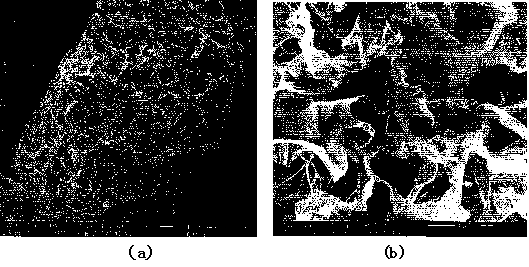Method for preparing crosslinked chitosan porous scaffold
A technology of cross-linking chitosan and porous scaffolds, which is applied in medical science, prosthesis, etc., can solve problems such as weak mechanical strength, achieve high porosity, wide application prospects, and reduce production and construction costs.
- Summary
- Abstract
- Description
- Claims
- Application Information
AI Technical Summary
Problems solved by technology
Method used
Image
Examples
Embodiment 1
[0021] The methanol suspension of 2% chitosan and the methanol solution of silane coupling agent KH-560 were configured respectively in mass percent;
[0022] Blend the methanol suspension of chitosan and the methanol solution of silane coupling agent KH-560 at a mass ratio of 70:30, heat up to 70°C, stir for 3 hours, filter with suction, and wash with anhydrous methanol repeatedly. Until the unreacted silane coupling agent KH-560 is washed and dried in vacuum at 60°C for 12 hours, cross-linked chitosan is obtained;
[0023] Dissolving the above-mentioned cross-linked chitosan in 100g distilled water, preparing an aqueous solution of 1% cross-linked chitosan by mass percent, degassing to obtain an aqueous solution of cross-linked chitosan after deaeration;
[0024] Pour the above-mentioned degassed cross-linked chitosan aqueous solution into a 10 mL microcontainer, and place it in a freezer at -30°C for 12 hours after being flattened, and then transfer it to a freeze dryer for...
Embodiment 2
[0027] Same as Example 1, but the concentration of the methanol suspension of chitosan and the methanol solution of silane coupling agent KH-560 in step (1) all changes from 2% to 1%, and the others remain unchanged.
Embodiment 3
[0029] Same as Example 1, but the concentration of the methanol suspension of chitosan and the methanol solution of silane coupling agent KH-560 in step (1) all changes from 2% to 3%, and the others remain unchanged.
PUM
| Property | Measurement | Unit |
|---|---|---|
| pore size | aaaaa | aaaaa |
| porosity | aaaaa | aaaaa |
Abstract
Description
Claims
Application Information
 Login to View More
Login to View More - R&D
- Intellectual Property
- Life Sciences
- Materials
- Tech Scout
- Unparalleled Data Quality
- Higher Quality Content
- 60% Fewer Hallucinations
Browse by: Latest US Patents, China's latest patents, Technical Efficacy Thesaurus, Application Domain, Technology Topic, Popular Technical Reports.
© 2025 PatSnap. All rights reserved.Legal|Privacy policy|Modern Slavery Act Transparency Statement|Sitemap|About US| Contact US: help@patsnap.com


